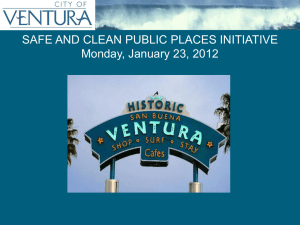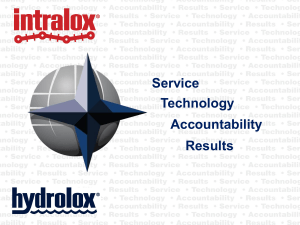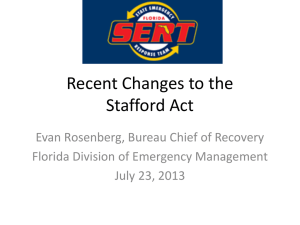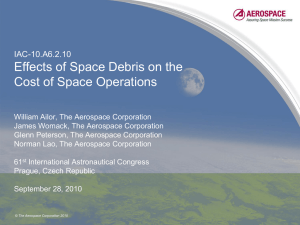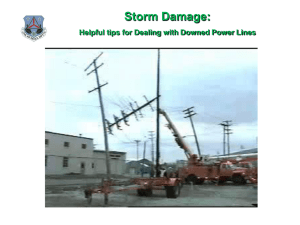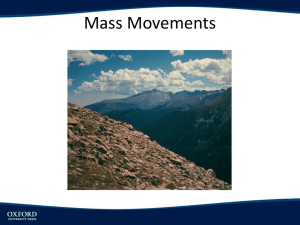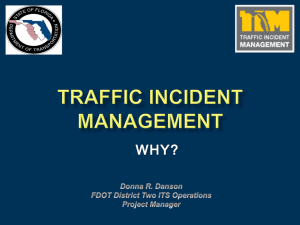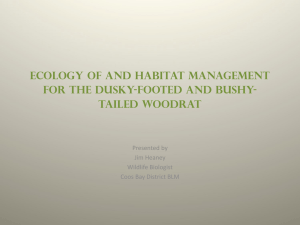SRIA Presentation
advertisement
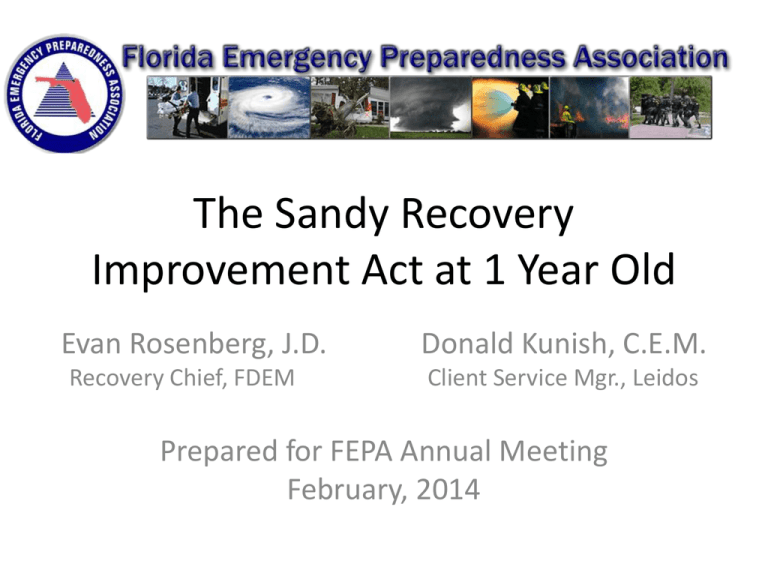
The Sandy Recovery Improvement Act at 1 Year Old Evan Rosenberg, J.D. Recovery Chief, FDEM Donald Kunish, C.E.M. Client Service Mgr., Leidos Prepared for FEPA Annual Meeting February, 2014 What was SRIA? • As a general reminder, the Sandy Recovery Improvement Act was enacted in 2013 with the goals of: – Reducing the costs to the Federal government of providing (Recovery) assistance, and: • Increasing flexibility in the provision of assistance, • Expediting the provision of assistance, and • Providing financial incentives and disincentives for the timely and cost-effective completion of projects with assistance SRIA Generally • The main provisions of SRIA were: – Payment of PA claims based on fixed estimates – Cost-recovery for regular-time emergency PA work (Cat A & B) – Incentivizing debris management planning – Incentivizing speedy debris management work – Small changes made to IA & HMGP programs Pilot Programs vs. Permanent Changes • FEMA was given authority to implement some changes permanently, and others as pilot programs: SRIA Program Pilot or Permanent? End Date PA Alternative Procedures Pilot No Fixed End Date Debris Management Alternative Procedures Pilot June 27, 2014 Cost Recovery of RT Emergency Work Salaries Permanent n/a Use of SRIA Provisions • Although there were retroactive provisions in SRIA, most of the SRIA changes came too late for use in the Superstorm Sandy Recovery! – PA Alternative Procedures have been scarcely used to date – Debris Management is being widely implemented, but has not been widely used to date Use of PA Alternative Procedures • PA Alternative Procedures have not been used in Region IV to date – PA Alternative Procedures were implemented in OK, during recovery from the Moore Tornado event (DR-4117) in May of 2013 • Rationale of the subgrantees was typically one of ‘the town is completely destroyed, let’s get the money as soon as possible!’ • Very few of the intricacies have been tested to date, other than the fixed nature of the grants Use of PA Alternative Procedures in OK • Comments provided by the OK Office of Emergency Management include: – Paperwork to implement alternative procedures includes a signed statement of the choice, – No rumblings of large underruns (yet!), – They do anticipate some use of the alternative arbitration process in lieu of second appeal (tbd), Use of PA Alternative Procedures in FL • We did have one disaster declared after SRIA was enacted (DR-4138, N. FL Severe Storms), but to date no subgrantees have used PA Alternative Procedures – Rationale most commonly heard is ‘we like the idea, but we want to see it used somewhere else first.’ Potential Issue with Alternative Procedures in FL • One commentator has opined that the payment of large projects based on fixed estimates should be treated as an “advance” under Florida Law – The Division will seek additional legal opinion on this, and may attempt to address through rulemaking or statutory changes Potential Changes to IA • As part of SRIA, Congress instructed FEMA to look at the threshold issue for declaring an IA Major Disaster – As of right now there is no “official” threshold codified in law or policy. The unofficial threshold is 100 homes with “major damage” or “destroyed” status, in at least one county. Potential Changes to IA (ctd.) • In mid-2013 FEMA convened a working group and solicited comments from the states, on establishing different thresholds based on state population – There would be 3 categories: large (>10 million), medium and small (<2 million) population states under the proposal • The Division argued against this model, arguing instead for a model based on population density of the impacted county Use of Debris Management Alternative Procedures • This is where most of the Post-SRIA action has been! – Debris Planning Component • Unaware whether anyone has utilized the “bonus” 2% for having a FEMA-reviewed debris management plan – Speedy Debris Work Component • This has been used a number of times across the nation, with very few negative comments resulting – A few subgrantees have complained that a lack FEMA monitors/personnel has caused them to miss important dates of Use of Debris Management Alternative Procedures in FL • To date we have not used these in FL either – No subgrantees chose to use the “one-time-only” 2% bonus federal cost share in DR-4138 – Likewise, DR-4138 was not a major debrisgenerating event, so the speed “bonus” was not utilized Debris Planning in FL • That being said, Florida subgrantees are preparing debris management plans, should the 2% bonus become meaningful: – 26 Counties have submitted plans to the state: • 19 have been sent on to FEMA • 7 returned to Counties for additional information – Of the 19 sent on to FEMA: • 9 have been approved by FEMA • 3 have been returned for rework • 7 pending FEMA determination In-Depth Discussion on Debris Reimbursement Options Comparison of Debris Reimbursement Options • Advantages and disadvantages to using both program procedures based on the following: 16 – Type of disaster – Type and quantity of debris – Special programs – Environmental considerations – Timeline Comparison of Debris Reimbursement Options (ctd.) Choose wisely… Comparison of Debris Reimbursement Options (ctd.) • Project Comparison: – Sioux Falls, South Dakota Ice Storm • • • Short-term debris removal project Vegetative debris Quick project completion – Bastrop, Texas Wildfires • • • 18 Long-term debris removal program Environmental concerns Special programs Comparison of Debris Reimbursement Options (ctd.) • Sioux Falls, South Dakota Ice Storm – Occurred in April 2013 – Combination of ice and wind caused trees to crack and fall – Hazardous hanging and leaning limbs 19 Comparison of Debris Reimbursement Options (ctd.) Sioux Falls, South Dakota Ice Storm Sliding Scale Option Timeline Eligible Work Federal Share Local Share Day 1 to 30 Cost Share: 85%/15% $863,487.88 $733,964.70 $129,523.18 Day 31 to 90 Cost Share: 80%/20% $125,653.55 $106,805.52 $18,848.03 Day 91 to 180 Cost Share: 75%/25% $0.00 $0.00 $0.00 Day 180+ Cost Share: 0%/100% $0.00 $0.00 $0.00 $989,141.44 $840,770.22 $148,371.22 TOTAL 20 Comparison of Debris Reimbursement Options (ctd.) Sioux Falls, South Dakota Ice Storm Standard Debris Option Eligible Work Federal Share Local Share $989,141.44 $741,856.08 $247,285.36 Comparison Program Federal Share Local Share Sliding Scale Option $840,770.22 $148,371.22 Standard Debris Option $741,856.08 $247,285.36 Difference of $98,914.14 federal cost share 21 Comparison of Debris Reimbursement Options (ctd.) • Bastrop, Texas Wildfires – Fire started September 4, 2011 – Tropical Storm Lee caused 30 mph winds – Most destructive wildfire in Texas history – 34,000 acres burned – 1,667 homes destroyed – 38 non-residential structures destroyed – 5,000 people displaced – 2 fatalities – 1.5 million trees killed 22 Comparison of Debris Reimbursement Options (ctd.) Bastrop, Texas Wildfires Sliding Scale Option Timeline Eligible Work Federal Share Local Share Day 1 to 30 Cost Share: 85%/15% $1,502,881.87 $1,277,449.59 $225,432.28 Day 31 to 90 Cost Share: 80%/20% $3,230,326.73 $2,584,261.38 $646,065.35 Day 91 to 180 Cost Share: 75%/25% $3,217,615.04 $2,574,092.03 $643,523.01 Day 180+ Cost Share: 0%/100% $9,732,477.24 $0.00 $9,732,477.24 TOTAL $17,683,300.88 $6,435,803.00 $11,247,497.88 23 Comparison of Debris Reimbursement Options (ctd.) Bastrop, Texas Wildfires Standard Debris Option Eligible Work Federal Share Local Share $17,683,300.88 $13,262,475.66 $4,420,825.22 Comparison Program Federal Share Local Share Sliding Scale Option $6,435,803.00 $11,247,497.88 Standard Debris Option $13,262,475.66 $4,420,825.22 Difference of $6,826,672.66 local cost share 24 Comparison of Debris Reimbursement Options (ctd.) • Sliding Scale Option: – Pros: • – 25 • Recycling Revenue Option: – Possible lower cost share Pros: • Possible increased funding for disaster programs with Recycling revenue • Innovative recycling methods that are more expensive are eligible Cons: • Cleanup cut off date • Must identify when debris actually reaches final disposal • Ensuring contractor urgency with final disposal – Cons: • Current contracts might not account for recycling revenues • Contractors consider revenues in unit pricing • Contracts may utilize cradle to grave pricing • Local may have given up ownership of debris
